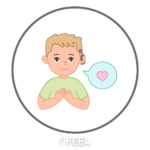
Emotional recognition is a crucial skill for preschoolers, particularly for those who may have special needs. Understanding and identifying feelings can enhance social interactions, improve communication, and foster empathy. One effective method to teach this skill is through the “Using the Big Three” activity. This approach focuses on recognizing emotions by observing the eyes, eyebrows, and mouth. In this blog post, we’ll explore how early childhood special educators can implement this emotional recognition activity for preschoolers with a comprehensive lesson plan and simple, no-prep activity ideas.
Why Emotional Recognition is Important
Emotional recognition helps children:
- Communicate their feelings more effectively.
- Develop empathy towards others.
- Improve social interactions.
- Reduce misunderstandings and conflicts.
Teaching these skills at an early age sets the foundation for better emotional intelligence as they grow.
The Big Three: Eyes, Eyebrows, and Mouth
The “Big Three” approach simplifies emotional recognition by focusing on three key facial features:
- Eyes: The shape and direction of the eyes can indicate various emotions, such as happiness, sadness, or anger.
- Eyebrows: The position and movement of the eyebrows can signal surprise, confusion, or frustration.
- Mouth: The shape of the mouth can show if someone is smiling, frowning, or feeling neutral.
Lesson Plan: Using the Big Three
Objective
By the end of the lesson, preschoolers will be able to identify basic emotions (happy, sad, angry, surprised) by observing the eyes, eyebrows, and mouth.
Materials Needed
- Emotion flashcards or pictures
- Mirror
- “Using the Big Three” worksheet (printable)
- Storybook featuring various emotions
Duration
30-45 minutes
Activity Steps
1. Introduction (5 minutes)
Begin the lesson by explaining the importance of understanding feelings. Use simple language and relatable examples. For instance, “When we know how someone feels, we can be a better friend.”
2. Explain the “Big Three” (10 minutes)
Introduce the concept of the “Big Three” (eyes, eyebrows, and mouth). Show pictures of different emotions. Point out how the eyes, eyebrows, and mouth change with each emotion. For example, show a happy face and highlight the upturned mouth and smiling eyes.
3. Mirror Activity (10 minutes)
Hand out mirrors to each child. Ask them to make different faces (happy, sad, angry, surprised) and observe how their eyes, eyebrows, and mouth change. Encourage them to describe what they see. This activity helps reinforce their understanding through self-observation.
4. “Using the Big Three” Worksheet (10 minutes)
Distribute the “Using the Big Three” worksheet. Students should match emoji expressions with Hugo’s corresponding facial expressions. Have students find the match.

5. Storytime and Discussion (10 minutes)
Read a storybook that features characters expressing various emotions. Pause occasionally to ask the children how they think the characters are feeling based on their facial expressions. Discuss the “Big Three” features for each emotion observed in the story.
Unlock ALL of our preschool materials by signing up for your free trial today – no credit card required!
Access the full Social Communication Curriculum HERE!
Instant access to thousands of no-prep social skills activities, over 1000+ video lessons, and engaging games designed to enhance learning and development.
Conclusion
Teaching emotional recognition to preschoolers is a vital step in their social and emotional development. The “Using the Big Three” activity offers a simple, effective method for early childhood special educators to help children identify and understand feelings. By focusing on the eyes, eyebrows, and mouth, children can learn to recognize emotions and improve their communication and empathy skills. Incorporate the provided lesson plan and no-prep activity ideas into your classroom to create a supportive and emotionally aware learning environment.
Sample Video
Students learn best from watching real students their own age model skills. Try out this sample video lesson. We offer our entire Social-Emotional Learning platform free for 14 days here!
Related Blog Posts:
Everyday Speech Pre-K Materials Are Here!
Fun and Engaging Social Skills Activities for Preschoolers
Free Preschool Self-Regulation Skills Material

